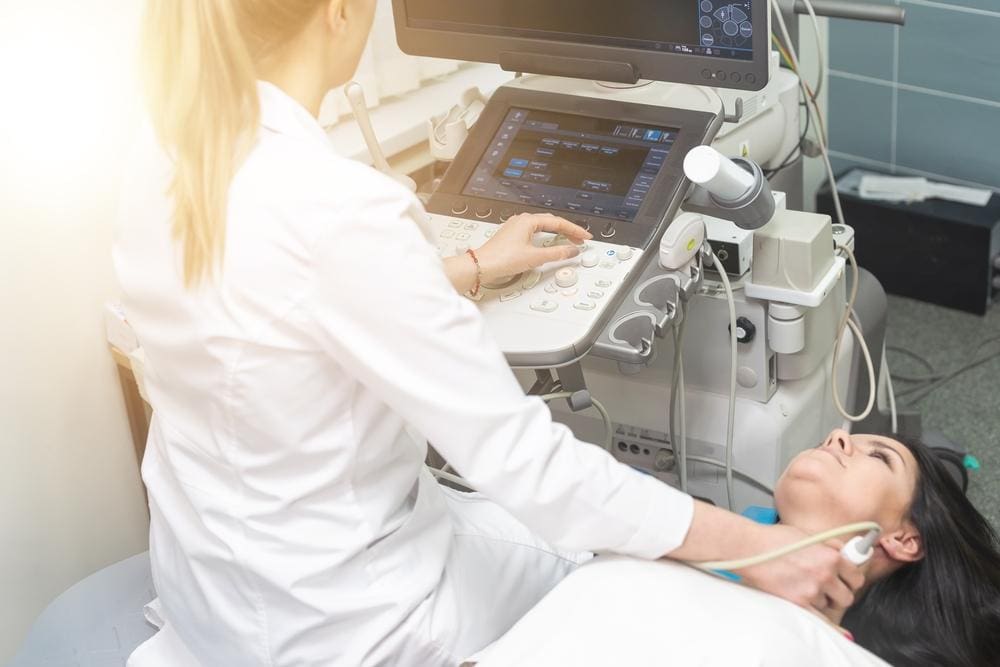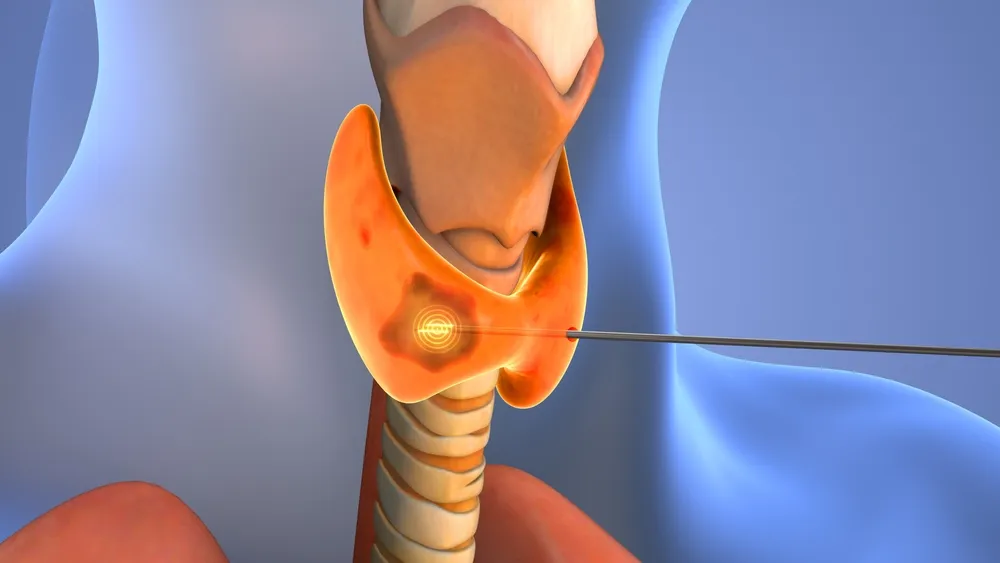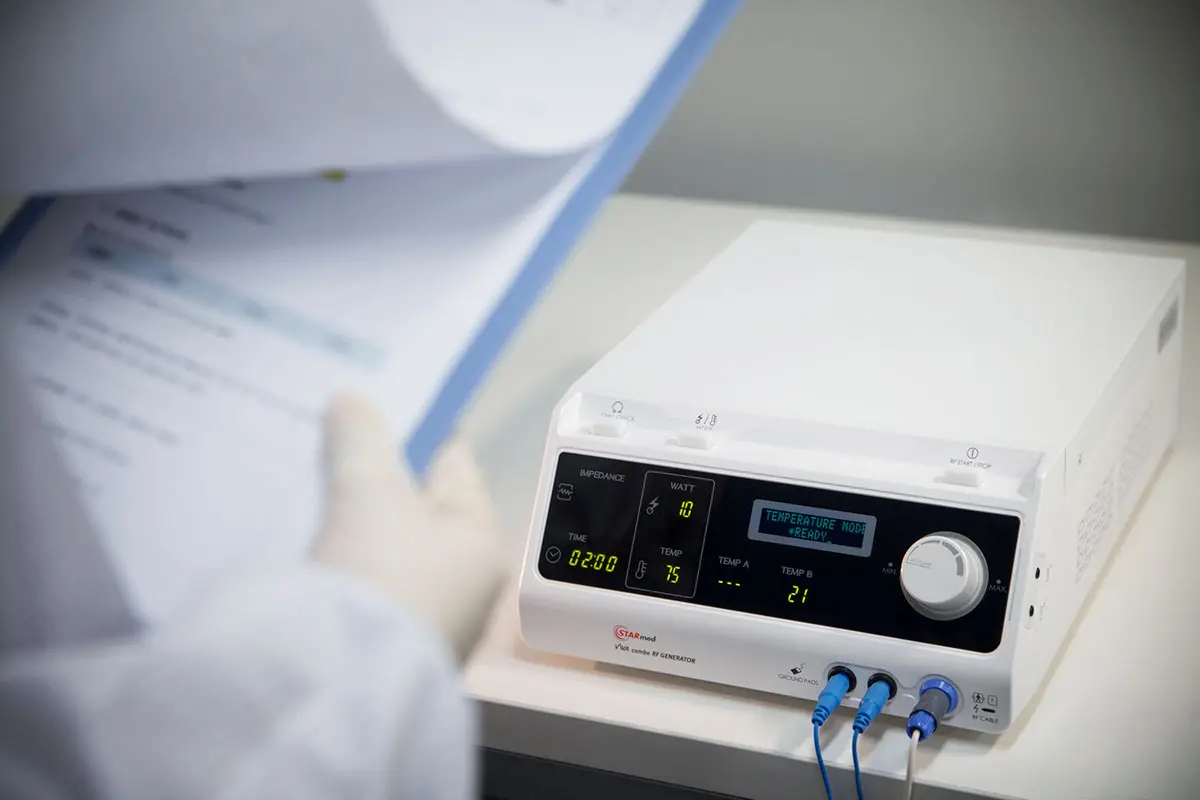Summary: Explore how to shrink thyroid nodules without surgery through safe, non-invasive therapies. Clinicians can now offer patients effective alternatives like RFA to reduce nodule size, preserve thyroid function, and avoid surgical risks.
- RFA is the most effective non-surgical option, offering 50–80%+ nodule reduction.
- Ethanol ablation works well for cystic nodules but is less effective for solid ones.
- Laser ablation is comparable to RFA but less commonly used in the U.S.
- Red light therapy is not clinically supported for thyroid nodule shrinkage.
- Most solid nodules do not shrink on their own and require active treatment.
- STARmed America offers advanced RFA systems and clinician training resources.
Benign thyroid nodules are common, impacting up to half the population at any given time. While most are small and asymptomatic, some can grow large enough to cause symptoms or cosmetic concerns. Traditionally, thyroidectomy surgery has been the first and most effective treatment option for symptomatic nodules. However, many patients and clinicians now ask how to shrink thyroid nodules without surgery, seeking less invasive alternatives.
In the past decade, several non-surgical therapies, such as radiofrequency ablation (RFA), have emerged. They are considered effective options to reduce nodule size while preserving the thyroid gland.
In this blog, we’ll review the non-invasive thyroid nodule removal approaches favored by clinicians today. Plus, we’ll address commonly asked questions about whether or not thyroid nodules can shrink on their own. Continue reading to learn how to improve patient comfort without surgery and how to train on these efficacious modalities.
Non-Invasive Thyroid Nodule Removal Options
Advances in interventional endocrinology and radiology have led to non-surgical, minimally invasive treatments for thyroid nodules. These procedures are done through needles or energy devices and are guided by ultrasound. They are frequently performed without any large incisions or general anesthesia. That makes them more appealing than surgical interventions for clinicians and patients alike.
Below, we’ll provide an overview of the most established non-surgical therapies. The options include alcohol ablation, laser ablation, and the current front-runner, radiofrequency ablation.
Radiofrequency Ablation (RFA)
Radiofrequency ablation has quickly become the most promising and widely adopted non-surgical therapy for benign thyroid nodules. RFA involves inserting a thin electrode into the nodule under local anesthesia and ultrasound guidance. The probe emits high-frequency radio waves that heat up and destroy the nodule’s tissue through thermal coagulation. Over time, the treated nodule shrinks as the destroyed tissue is resorbed and replaced by scar tissue.
Multiple international studies have demonstrated that RFA can achieve significant nodule shrinkage. Typical volume reductions average around 50–80% after a single treatment. Many cases exceed 80% reduction, depending on nodule composition and the follow-up duration. Importantly, the thyroid gland itself is preserved, and patients typically won’t require lifetime medication.
Unlike surgery, RFA requires no general anesthesia and leaves no surgical scar on the neck. The risk of hypothyroidism is very low because the majority of normal thyroid tissue is untouched. The most frequent minor issues are temporary pain or transient voice hoarseness. There is no need for hospitalization, and patients frequently resume normal activities within 24 hours.
RFA offers a true “non-invasive thyroid nodule removal.”

Ethanol Ablation (Percutaneous Ethanol Injection)
Percutaneous ethanol injection (PEI), also known as ethanol ablation, is the oldest non-surgical thyroid nodule therapy. It involves an injection of medical alcohol directly into the nodule. The alcohol induces cell dehydration and coagulative necrosis, causing the nodule to scar and shrink.
For predominantly cystic nodules, PEI has a very high success rate. Studies show that ~80–100% of cystic nodules significantly shrink or resolve after 1–3 ethanol treatments. Studies have revealed an average volume reduction of around 60% or more.
However, PEI is less effective for solid nodules. That’s because ethanol doesn’t penetrate solid tissue evenly. The main side effects can be pain or a burning sensation during the injection. Furthermore, if ethanol leaks, it can irritate nearby tissues.
If a nodule has both solid and cystic components, sometimes PEI is combined with another therapy. For example, a clinician might drain the cyst with ethanol and then perform RFA on the solid part in a separate session.
Laser Ablation
Laser ablation of thyroid nodules is another thermal therapy. While similar in concept to RFA, it uses laser energy delivered via a fiber inserted into the nodule. As with RFA, the laser heats and destroys the tissue, leading to shrinkage over time.
Laser also has the advantage of being a minimally invasive outpatient procedure performed under local anesthesia. Likewise, the complication profile is similarly low when compared with RFA.
A 2015 systematic review and network meta-analysis concluded that both laser and RFA significantly reduce nodule size. Specifically, laser ablation achieved a mean volume reduction rate (VRR) of approximately 52% at 12 months post-procedure. In comparison, RFA demonstrated a higher mean VRR of about 70.9% at the same 12-month follow-up
However, RFA tended to produce greater volume reduction than laser in benign solid nodules. Likewise, RFA devices have become more common, and some clinicians find RFA technique more straightforward for larger nodules.
Red Light Therapy
Red light therapy is also known as low-level laser therapy (LLLT) or photobiomodulation. It usually involves shining red or near-infrared light on the skin, ostensibly to stimulate cellular activity.
Patients may wonder, can red light therapy shrink thyroid nodules? At this time, there is no solid scientific evidence to support red light therapy for reducing thyroid nodule size. There have been very few studies on the topic, and those that have been published do not address significant nodule shrinkage as an outcome.
In fact, one experimental study found that the red light treatment had no significant effect on nodule volume or function. In that study, a group receiving red light showed no change in nodule size compared to controls.
To date, red light therapy is not an approved or recommended treatment for thyroid nodules in any medical guidelines. Patients with symptomatic nodules will benefit far more from the established therapies discussed above.
Can Thyroid Nodules Shrink on Their Own?
In some cases, small benign nodules may remain the same size for years or shrink slightly without any intervention. For example, fluid-filled cystic nodules might shrink if the fluid slowly reabsorbs. Likewise, nodules associated with thyroiditis could be reduced once the inflammation subsides.
In general, however, significant spontaneous shrinkage of solid thyroid nodules is uncommon.
Historically, doctors tried giving patients thyroid hormone medication (to suppress TSH) in hopes of shrinking nodules. Those efforts showed little benefit in most cases. Thus, they are no longer routinely recommended in guidelines. For nodules that do cause problems, active treatment is often needed to achieve meaningful volume reduction.
Enter a New Era of Thyroid Nodule Management with STARmed
Non-invasive thyroid nodule removal techniques empower clinicians to offer effective therapy to patients who seek to avoid surgery. RFA is currently the gold standard for minimally invasive thyroid nodule treatment.
Discover how STARmed America is advancing non-surgical thyroid care with state-of-the-art radiofrequency ablation technology. Learn more about our RFA systems, clinical support, and training resources tailored for physicians like you.





